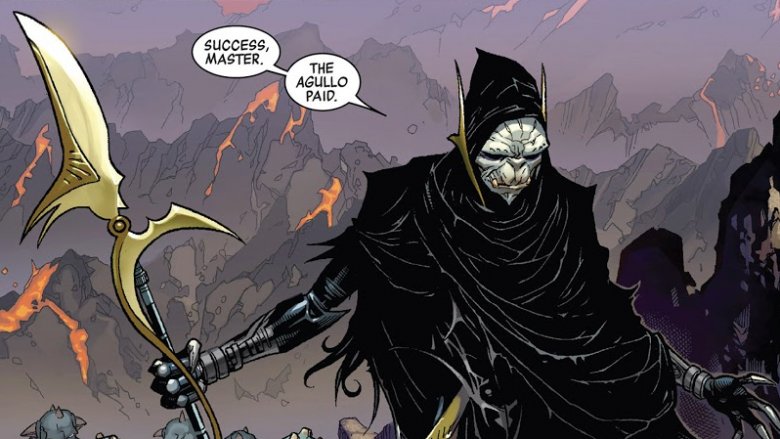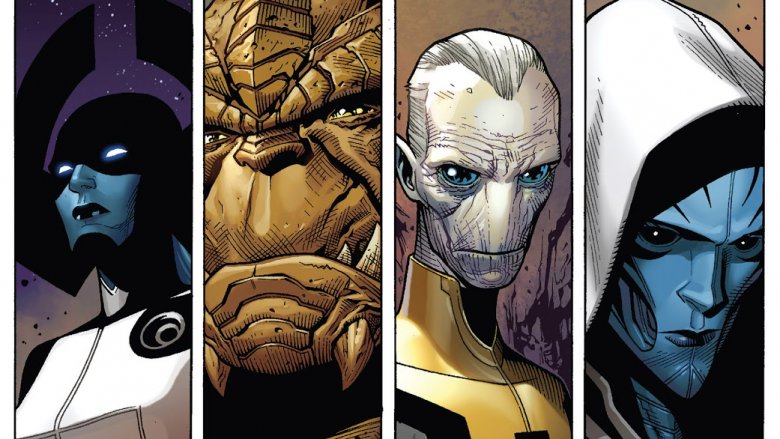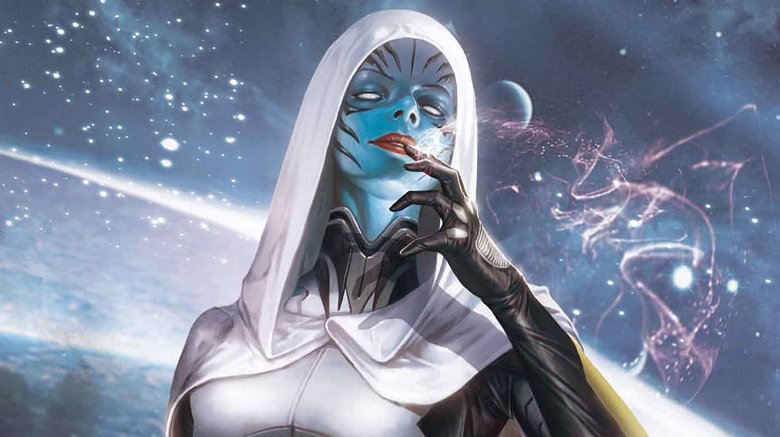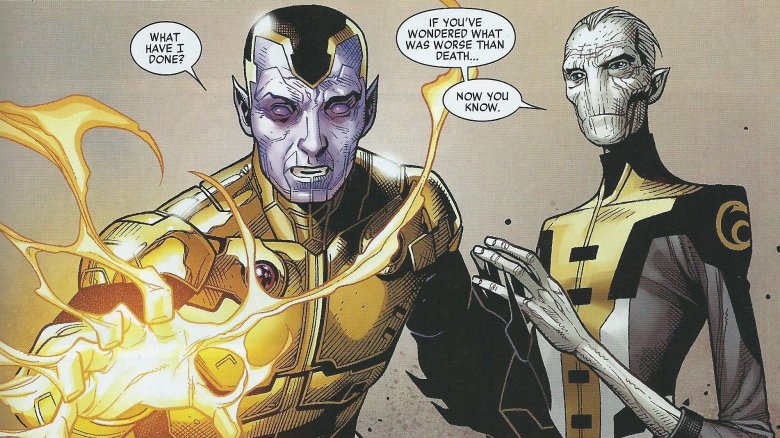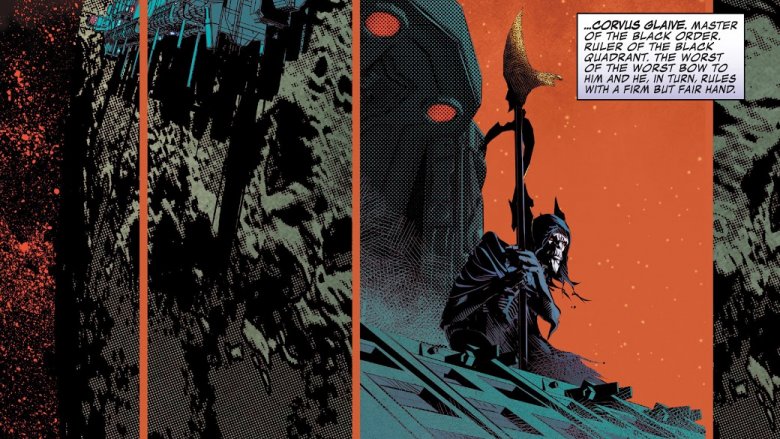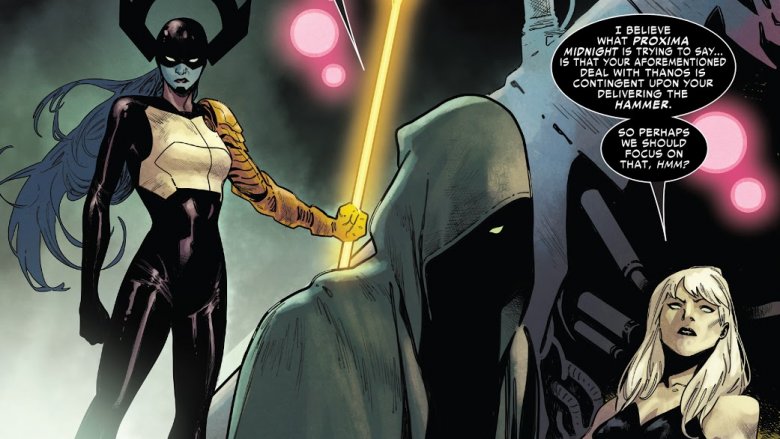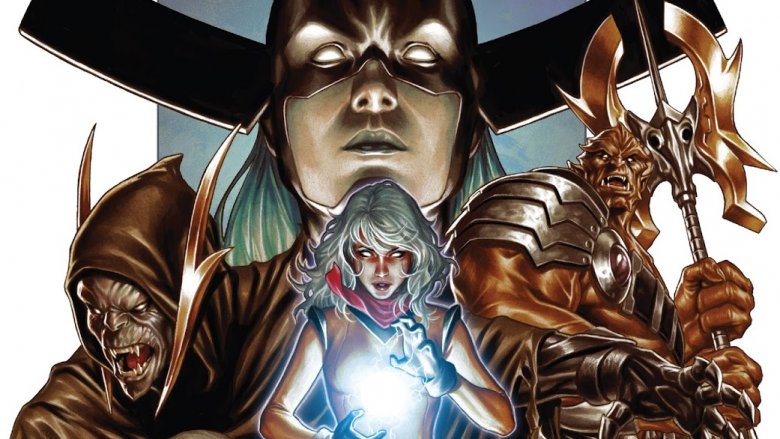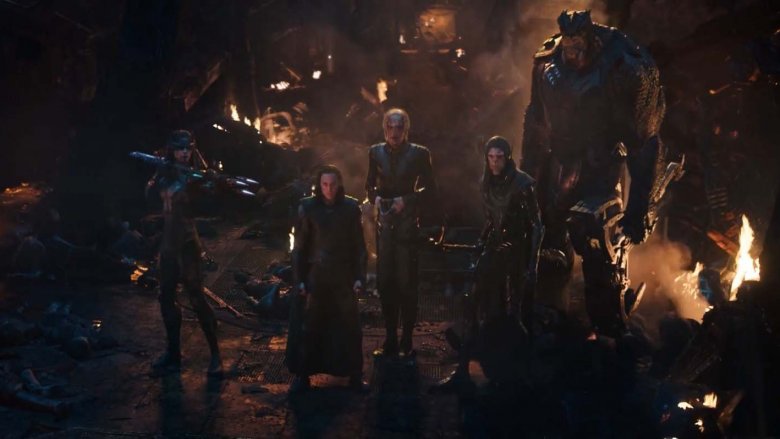The Truth About The Black Order
Thanos is coming to Earth, and he's bringing the kids. The Black Order — aka Cull Obsidian, aka the Children of Thanos — are the deviant Eternal's trusted coterie of personal supervillains, being introduced to wide audiences for the first time in Avengers: Infinity War.
In the movie, the quartet joins along with Thanos' mission to acquire all six stones of the Infinity Gauntlet, helping him to realize a nihilistic goal of universal domination. But in the comics that they come from, the group goes on all sorts of missions for the Mad Titan — some of them downright wacky.
Like many of the Marvel Comics characters that make the jump to movie screens, a lot needed to change to bring the Black Order to life. In making the transition to moviedom, the group had its numbers reduced, its members renamed, and the power sets of its members mildly switched up. But whether it's a comic book script or a screenplay, one thing's remained consistent for the Black Order — these folks aren't your typical henchmen. Whether you've seen Infinity War and have a few lingering questions, or want a quick primer before you check the movie out in the first place, read on as we break down everything you need to know about Thanos' Black Order.
Cull Obsidian
Unlike many characters in Marvel Comics, the Black Order have a history that's easy to catch up on. But just because they're relatively new to the universe doesn't mean the finer details about them aren't needlessly complicated; we are still talking about comic books, after all.
Introduced by writer Jonathan Hickman in the 2013 Thanos-centric storyline Infinity, the group as originally written consists of five members, all of whom sound like they have the names of Cannibal Corpse albums. Thanos' personal starting lineup consists of Corvus Glaive, Black Dwarf, Proxima Midnight, Ebony Maw, and Supergiant, all of whom have the appearances of angular-faced, shifty-looking demon people.
In the Infinity storyline, the Black Order serve as Thanos' combination heralds and tax collectors. Their purpose is to roam from world to world, extracting tributes from planetary populations in order to please their master.
It's more than a mere mob tactic. The Infinity story quickly establishes that Thanos' tributes don't consist of money — they consist of boxes full of severed heads. Subtle! In keeping with the kickass names of the Black Order, this is a pretty metal way to introduce a group of villains.
The skilled set
Aside from being pure evil, doggedly loyal, and aesthetically edgy, what do the Black Order have to offer? Much like the Avengers, the Fantastic Four, or the band KISS, every member brings a little somethin'-somethin' to the table.
Corvus is the ostensible leader of the group, a stalwart brown-noser and wiry shrew who is strong, fast, invulnerable, and — thanks to a magical glaive weapon — conditionally immortal. His wife, Proxima Midnight, is similarly powerful and loyal to Thanos, with her weapon of choice being a three-pronged spear that when thrown possesses homing capabilities, fueled by lethal black light. (Which is not to say "ultraviolet light". It shoots, uh, evil light.)
Black Dwarf received a name change on his way to the Infinity War movie, being renamed Cull Obsidian for the film after the alternate team moniker. His power set, however, remains the same, with the character being the big bruiser of the Black Order team. Similar in look and ability to Ben Grimm, BD/CO is strong, brutish, heavy, and possessing of unbreakable skin.
Ebony Maw is the brains of the operation, a physically-unimposing telepath who uses his sinister wits to divide and conquer. Manipulative and devious, this scrawny brainiac is typically the member of the team you most want to see get the Hulk-smash treatment.
These four made it to the Infinity War movie more-or-less intact, but they also subsumed the abilities of the comics' fifth member, who — for whatever reason — didn't make the cut.
Supergiant
The one member of Thanos' original Black Order who didn't make it to the red carpet has a name that's more suitable for a progressive rock band than a metal band — which is just something that we noticed, not necessarily the reason she was left behind.
When the rest of the Black Order made their big promotional debut at Disney's D23 Expo, Supergiant was conspicuously absent. And it's not because she wasn't important, powerful, or interesting enough. In the Infinity storyline, the blue-skinned Supergiant is an integral member of the team, an immensely powerful psychic who is able to control physical matter and also other superheroes' minds. Though she dies in the story that introduced her, she's so powerful of a telepath that she was able to continue existing later on with no physical body.
Presumably, her death in Infinity contributed in some small part to the decision to leave her out of Infinity War — but according to co-director Joe Russo, the decision was mostly necessitated by the movie's already obscenely-large cast.
"We are dealing with so many characters that we made some choices along the way," Russo said, speaking to Coming Soon during the lead-up to Infinity War's release. "Consolidation seemed like a smart thing to my brother and I because they were starting to overlap each other. And frankly, when you see the movie, you'll understand. It services the storytelling."
Thanos Thane Thanoson II
In the Infinity War movie, the Black Order exists in a de facto sense as a bunch of bootlickers who are riding Thanos' quest to universal domination with the obvious goal of being close to the seat of power. But in the comic arc that introduced them, they weren't chasing after the Infinity Stones — instead, they were out searching for something much more specific and strange.
As the Infinity story slowly reveals, Thanos isn't having his sadistic super-squad jet around the universe collecting heads for simple grins and giggles. Rather, he's having them search for his son, Thane.
You'd probably never guess this, but Thanos hates his son to a homicidal extent. Why? Well ... we wish there was a good reason. According to Thanos himself, "the very idea" of his long-lost son being out there somewhere and existing is enough of a reason to want to kill him. As a motivation for mass murder, it's immensely lame. But isn't that just the most Thanos thing ever?
Corvus takes control
The Black Order's history in comic books isn't solely beholden to the Infinity storyline. After that Earth-invading crossover event ends with Thanos and Proxima Midnight in captivity, Corvus Glaive decides to keep the throne warm, as it were.
With his wife and his master both out of the picture, Corvus lets his hair down and assembles his own version of the Black Order, setting up a headquarters on a moon that used to belong to the Mad Titan. There, Corvus sets up his own version of the Black Order, reimagining the quintet as a massive army of merciless efficiency. It's a pretty good situation for the former shameless bootlicker — until Thanos comes back, and reintroduces his boots to Corvus' face.
In taking control of Corvus' Black Order, Thanos decapitates the organization, taking out his former second-in-command within the first moments of his return. Thanos doesn't do him in with his own two hands — instead, he forces Corvus to take up the shattered pieces of his own weapon and take his own life. Despite the cruelty, it's among the most awesome things that Thanos — a needy guy who is generally a whiner that actually sucks — has ever done.
Hammer time
Outside of the Infinity story that introduced the Black Order as ruthless and nigh-unkillable, the Black Order's adventures are a little bit... silly.
After Corvus was dealt with, Thanos formed a new Black Order team, composed in part of ride-or-die OG member Proxima Midnight and the multiversal traveler Black Swan. This time, their mission referenced a relic from the comics' Ultimate Universe, a.k.a. Earth-1610 (as opposed to the "regular" universe of Earth-616).
Instead of conquering planets and terrorizing worlds, this stripped-down iteration of the Black Order was formed for the sake of committing a simple heist.
The story, told in the pages of The Unworthy Thor, followed the group's quest to fetch Ultimate Thor's hammer for Thanos' use after the artifact crossed over to their reality. Joined by Hela, god of death, they embarked on a quest to liberate the hammer from the Collector — a quest they failed in, reaching the hammer but being unworthy of lifting it. The embarrassing failure was the clearest sign yet of the team's diminishing returns as a fighting force.
No Surrender
No matter how seriously a villain or a threat is introduced in the world of comics, at some point, some wiseacre of a writer is going to put them in a story that's basically a big goof. Sometimes you just want to see super-people fight each other gladiator-style, right?
The 2016 Avengers storyline "No Surrender" reduced the Black Order to their elemental roles as pawns of a much stronger entity, playing a game that exists beyond their comprehension. As part of a contest between the Grandmaster and the Challenger, the Black Order were pit against a version of the group called the Lethal Legion to duke it out in a world-spanning scavenger hunt, which is just the most undignified thing, relative to how the team got started.
By the time this storyline rolled around, many of the Black Order had died from infighting or plain disappeared, necessitating a mass-scale revival of the dead members on behalf of the Challenger. This iteration of the team brought the whole band back together, with the team being forced to go up against not only the Lethal Legion, but also all the usual good guys, like multiple teams of Avengers. It's a hokey setup, sure — but you can't honestly say it's not a lot of fun.
Blockbuster night
Principally identified as the Children of Thanos, the Black Order show up in Avengers: Infinity War and immediately began asserting dominance over the heroes — and anti-heroes — of the Marvel Cinematic Universe.
While the team had been somewhat alluded to in Guardians of the Galaxy, the 19th mega team-up MCU movie serves as their big debut on screen. Ostensibly, the Children of Thanos are the "siblings" of Gamora and Nebula, Thanos' other two adopted daughters in the MCU. The implication makes Thanos much more of a father figure in the movies than he typically was in the comics — after all, remember how much he hated Thane?
The movie sees Corvus Glaive being portrayed by New York actor Michael James Shaw, Proxima Midnight being played by The Leftovers' Carrie Coon, Irish actor Tom Vaughan-Lawlor taking on the role of Ebony Maw, and stunt performer/mo-cap actor Terry Notary as the renamed Black Dwarf, Cull Obsidian.
The movie makes each of the Order's members into formidable foes, with Proxima spearheading the bad guys' big assault on Wakanda, and Ebony taking on Doctor Strange in a battle of wits and wills. Not to stray into spoiler territory, but the other two get their moments against the Earth's Mightiest Heroes as well. Suffice to say, it's a good thing Nebula and Gamora's family issues got in the way of their being on Thanos' team for this fight. With their help, who knows? The Black Order might have been pretty much unstoppable.
